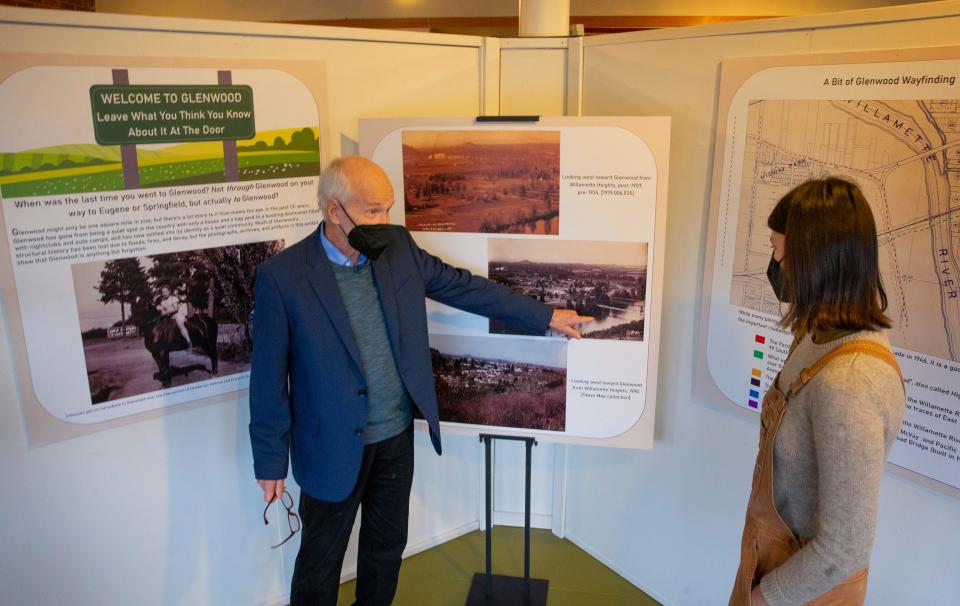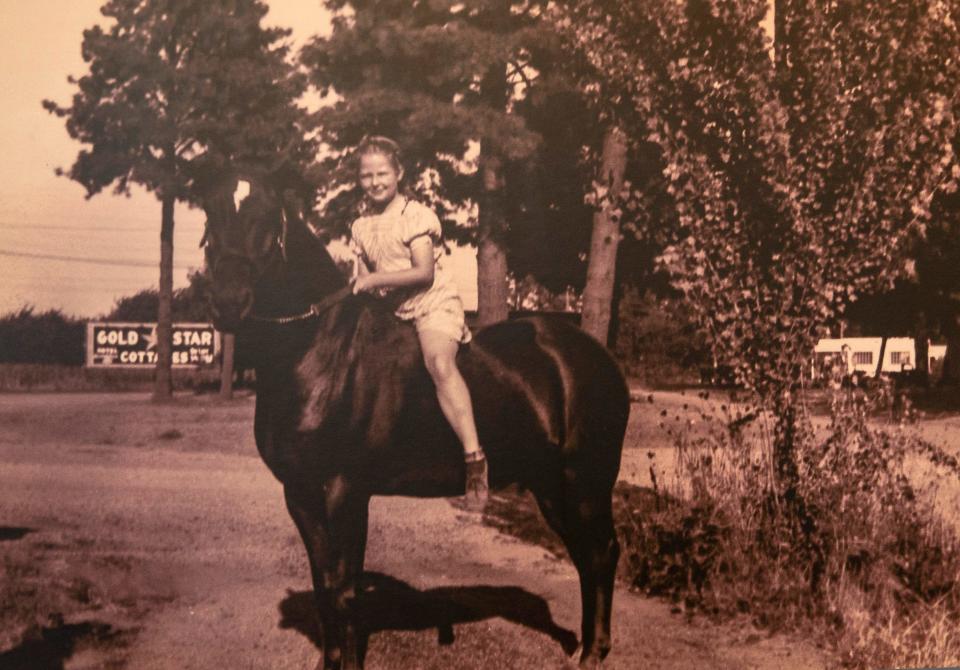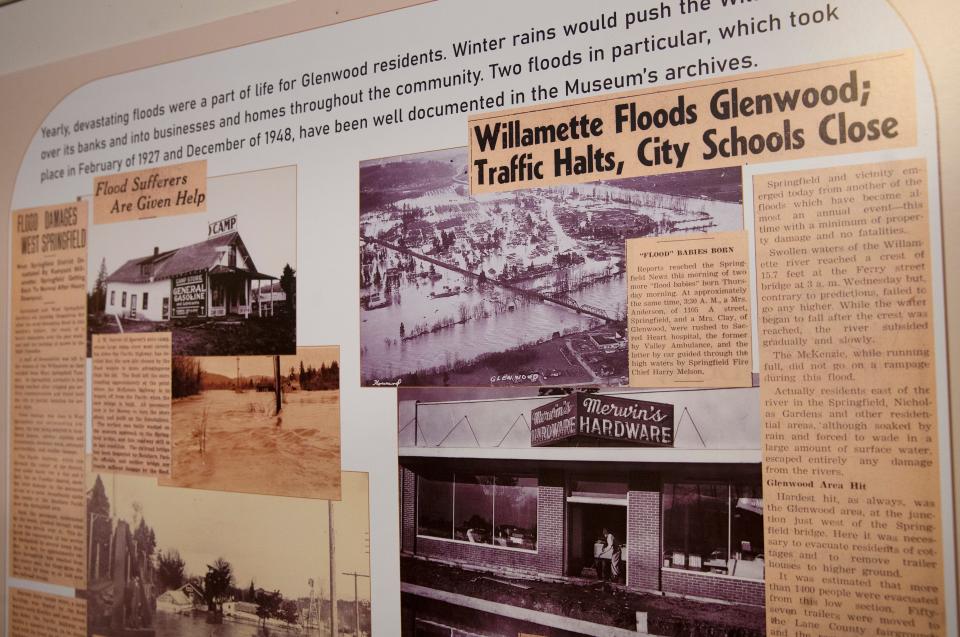At Springfield History Museum, leave what you know about Glenwood at the door
A little boy in an orange-topped hat rides a tricycle through flooded Glenwood streets in a video at the Springfield History Museum.
It’s Steve Moe, a current Springfield City Councilor who was born in the one-square-mile community in 1942, in a family video from decades ago.
Moe donated a large amount of his family’s collection of photos and videos to a new exhibit that asks people to “leave what you think you know about Glenwood at the door.”
The items Moe donated comprise about half of the “Glenwood Untold” exhibit, said museum curator Maddi McGraw. The exhibit, which opened Jan. 14, runs through June 24.
Glenwood in Moe’s childhood was a city, he said — it had a school and three grocery stores, and he remembers helping build a community church.
The community developed steadily from 1888 until the mid-1900s, when it started deteriorating after the construction of Interstate 5 rerouted most travelers and “resulted in a devastating loss of visitors to the area,” one of the exhibit boards reads.
“Much of Glenwood’s structural history has been lost due to floods, fires and decay, but the photographs, archives and artifacts in this exhibit show that Glenwood is anything but forgotten,” an introduction at the start of the exhibit says.

Curator has 'always wanted to do an exhibit on Glenwood'
McGraw started with the museum about four years ago and has “always wanted to do an exhibit on Glenwood.”
She lived in Ohio for a while and loved Rust Belt cities like Cleveland and Pittsburg, which have a fierce sense of community. People who are from those cities can diss the area, she said, but outsiders get vehement reactions when they insult the city.
“I’ve loved places like that, and Glenwood is that,” McGraw said, adding she likes underdog stories.
As she went to learn more about the area, she was hampered by the coronavirus pandemic.
McGraw knew Moe as a supporter of Springfield history and of Glenwood as not just what it could be, but also what it is and has been.
The two spent hours in Moe’s office looking at photos and artifacts and going over stories, and McGraw supplemented that with information from Springfield News archives, the Lane County History Museum and other sources.
Glenwood was like a city
Moe has a lot of stories about Glenwood.
He remembers when it was regular stop for people headed north to Washington or south to California on US 99 — years before I-5 was complete.

He remembers the regular flooding before Lookout Point Dam and other dams.
Glenwood flooded every couple years, Moe said, and residents “were just prepared for it.”
His family would hammer a board across storage areas to keep chopped wood from floating away. Someone told him once that they got through the flood with “a deck of cards and a fifth of whiskey.”
Moe remembers Glenwood as a city — when he was born, the population was half of Springfield’s.
While some of the buildings from Moe’s youth are still there, others were destroyed in floods or fires.
There was a major fire in the 1940s where the U-Haul is located now on Franklin Boulevard. Glenwood didn’t have its own fire protection then, the exhibit says, and neither Eugene nor Springfield’s fire departments would respond.
After several hours, Junction City volunteer firefighters showed up, and Springfield eventually sent a water tanker to help.

Nearly half of the community, known as West Springfield at that point, burned down. The fire caused $100,000 in damage — the equivalent of $1.9 million today with inflation.
Glenwood wasn’t incorporated into a city as other nearby communities were, Moe said, and started to see damage and deterioration.
Exhibit a 'celebration' of Glenwood
Still, families have remained in the small community for decades.
McGraw hopes the exhibit serves as a “celebration for the people who live in Glenwood” and a way for people who don’t live there to learn about the community as it is and has been.
There’s a sort of dual nature to Glenwood, McGraw said. It’s a place where people often were misused and mistreated by outsiders but where the community itself was welcoming and banded together, she said.
Early buildings were centered around community, she said, from the school to restaurants and nightclubs to the church.
The exhibit is photo-heavy, she said. That’s not typical of the exhibits McGraw curates, but it’s the case for this one because there weren’t a lot of artifacts available.
There’s one case of artifacts, and it includes one of McGraw’s favorite parts of the exhibit — a menu from Clingman’s.
Otis “Bo” Clingman opened the restaurant in Glenwood after wrestling from the 1920s to the 1940s. As McGraw looked into Clingman, she found articles and a lot of history around him, including a friendly rivalry with another former wrestler who owned a bar and nightclub in Eugene.
She wants to learn more about Clingman and about the nightclubs that operated in Glenwood and wishes she had more to include about them in the exhibit.
Museum hopes for more stories, artifacts
McGraw hopes the exhibit opens up the floodgates to get people to share their stories about Glenwood.
There’s a note board where people can share memories on the last panel of the exhibit, and a sheet of paper encourages people to email McGraw if they have photos, artifacts or archives related to Glenwood.
Because the exhibit runs for six months, McGraw is hopeful others will start to bring in their histories like Moe did. Some people might think the museum doesn’t want their item, she said, but “we absolutely want it.”
“I want all the objects that tell all the stories,” McGraw said. “And I want the stories with them.”
Officials 'excited about gently reinvigorating Glenwood'
The exhibit alludes to the future of Glenwood and plans for redevelopment but doesn’t directly address them.
Franklin Boulevard has been ready for development for some time, Moe said, but it just hasn’t been happening.
The city’s economic development agency recently approved a partnership with Edlen & Co. and deChase Miksis to redevelop around 9 acres of publicly owned property within Glenwood.
Read more: 'A shot ... of enthusiasm': Springfield negotiating with development team on Glenwood riverfront
Officials are “really excited about gently reinvigorating Glenwood,” Moe said.
Contact city government watchdog Megan Banta at mbanta@registerguard.com. Follow her on Twitter @MeganBanta_1.
'Glenwood Untold'
When: Through June 24
Where: Springfield History Museum, 590 Main St.
Hours: Only open 11 a.m. to 4 p.m. Saturdays, due to COVID
Information: www.springfield-museum.com or call 541-726-2300
This article originally appeared on Register-Guard: Springfield History Museum exhibit a 'celebration' of Glenwood

